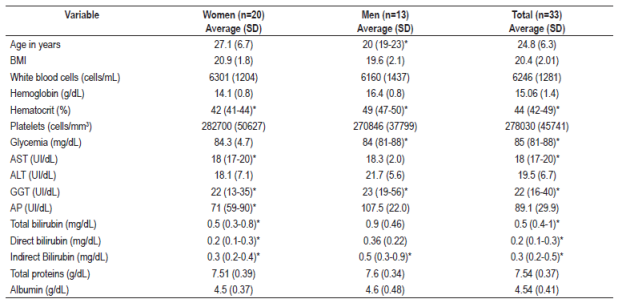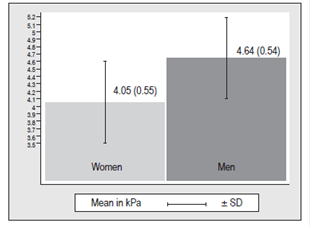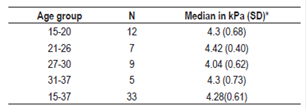Services on Demand
Journal
Article
Indicators
-
 Cited by SciELO
Cited by SciELO -
 Access statistics
Access statistics
Related links
-
 Cited by Google
Cited by Google -
 Similars in
SciELO
Similars in
SciELO -
 Similars in Google
Similars in Google
Share
Revista colombiana de Gastroenterología
Print version ISSN 0120-9957
Rev Col Gastroenterol vol.32 no.4 Bogotá Oct./Dec. 2017
https://doi.org/10.22516/25007440.176
Original articles
Behavior of Real Time Supersonic Shear Wave Elastography in Healthy Subjects in Bogota
1Centro De Enfermedades Hepáticas y Digestivas (CEHYD), Bogotá, Colombia
2Universidad Industrial de Santander, Bucaramanga, Colombia
3Hospital Universitario Nacional De Colombia, Grupo Equidad en Salud, Facultad de Medicina, Universidad Nacional de Colombia, Bogotá, Colombia
Introduction:
Real-time supersonic shear wave elastography (SSI) is a noninvasive test that is used to determine the elasticity of the liver and thus calculate the degree of liver fibrosis. Sometimes, it can replace a liver biopsy, and it is useful for monitoring the majority of patients with liver disease. In Colombia, the test has recently been introduced, so there have been no studies of test in healthy people here until now.
Objective:
The objective of this study was to evaluate the behavior of the elastography in real time in healthy subjects in Bogotá.
Materials and methods:
This is a retrospective pilot study of healthy subjects between 15 and 37 years old who underwent SSI between June 1, 2016 and March 31, 2017. A clinical history was taken and basic evaluation of liver function was performed to rule out abnormalities.
Results:
The series included 33 healthy subjects, 60.6% women and 39.4% men with an average age of 24.8 years. When the test was performed, an average value of 4.28 kilopascals (kPs) was found, with minimal difference between the sexes but greater hepatic rigidity in men.
Conclusions:
The mean values of hepatic rigidity in 33 healthy subjects in Bogotá are the same as those reported in the initial studies internationally. These findings suggest that the test may be very useful for the evaluation of patients with liver disease in our environment.
Keywords: Real-time elastography; supersonic; hepatic fibrosis; healthy adults
Introducción:
La elastografía en tiempo real (supersonic) es una prueba no invasiva que se utiliza para determinar la elasticidad del hígado y de esa forma calcular el grado de fibrosis hepática; en algunas ocasiones, reemplaza la toma de la biopsia hepática y es útil para el seguimiento de la mayoría de pacientes con hepatopatías. En Colombia, la prueba se introdujo recientemente y no existen hasta el momento estudios del comportamiento de la prueba en personas sanas.
Materiales y métodos:
estudio piloto retrospectivo de sujetos sanos entre 15 y 37 años, entre el 1 de junio de 2016 y el 31 de marzo del 2017. Se realizaron la historia clínica y evaluación básica de la función hepática para descartar anormalidades.
Resultados:
la serie incluyó 33 sujetos sanos, 60,6% mujeres y 39,4% hombres con una edad promedio de 24,8 años. Al practicar la prueba se encontró un valor promedio de 4,28 kilopascales (kPa), con una diferencia mínima entre sexos, siendo mayor la rigidez hepática en los hombres.
Conclusiones:
los valores promedio de la rigidez hepática en 33 sujetos sanos en Bogotá son los mismos reportados en los estudios iniciales de las pruebas a nivel internacional; estos hallazgos sugieren que la prueba puede ser muy útil en nuestro medio para la evaluación de pacientes con hepatopatías.
Palabras clave: Elastografía en tiempo real; supersonic; fibrosis hepática; adultos sanos.
Introduction
Chronic liver diseases gradually develop different degrees of fibrosis that can culminate in cirrhosis. Staging this disease is of constant interest for determination of the need for early intervention, as in the cases of hepatitis C and B. 1-3 Staging also generates prognoses for these and other liver diseases. Classically, the determination of the degree of fibrosis has been established with liver biopsies, but the risks of an invasive procedure, the costs, and sometimes refusal to have the procedure by the patient have led to the emergence of alternative non-invasive markers for liver fibrosis. 4-9
Real-time, or Supersonic, Elastography (Shear Wave elastography™ - SWE) is an ultrasound-based elastography technique that has the ability to map and measure liver stiffness. 10 Aixplorer® has been implemented in an ultrasound system which provides a two-dimensional, quantitative color imaging of the rigidity of liver tissue in real time. The Supersonic is a non-invasive test that determines the elasticity of the liver and calculates the degree of liver fibrosis. In some cases, it can replace a liver biopsy and is useful for monitoring the majority of patients with liver disease. 11-14
The test has only recently been introduced in Colombia, so there have been no studies of the behavior of the test in our environment to date. Consequently, the objective of this study was to evaluate the behavior of elastography in real time in healthy subjects in a medical center for liver diseases in Bogotá.
Materials and Methods
A retrospective pilot study was conducted in healthy volunteers between 15 and 37 years of age at a medical center in Bogotá between June 1, 2016 and March 31, 2017. Verbal consent for testing was provided by individuals included in the study. Information on the complete medical history was obtained and physical examinations and basic evaluations of liver functioning were conducted to rule out abnormalities. The inclusion criteria were based on including healthy individuals.
The medical history discarded any antecedent of importance for hepatopathy (history of hepatitis, transfusions, drug addiction, obesity, alcohol consumption and among others).
The physical examination was considered normal if there were no stigmata of chronic liver disease and the liver was normal upon palpation.
The body mass index (BMI) was normal (between 18 and 25 kg/m2).
Basic paraclinical tests were within normal limits:
Transaminases were less than 30 international units (IU)/dL
The international normalized index (INR) was between 0.8 and 1.2.
Bilirubin was between 0.3 and 1.3 mg/dL.
Albumin was between 3.5 and 5.0 g/dL
After inclusion, all participants underwent Supersonic elastography following the protocol recommended by the manufacturer. Real-time elastography was performed using the Aixplorer ultrasound system® (SuperSonic Imagine SA Aix-en-Provence, France) with a broadband convex probe (SC6-1). In SWE mode, shear waves were created in the tissue from the acoustic radiation force generated by pulses of ultrasound. The speed of the cutting wave is estimated by means of Doppler acquisition. 10 Cutting wave velocity is used to calculate the stiffness of tissues with the formula E = pc2 where E is the elasticity of the tissue in kPa, p is the density of the tissue in kg/m3, and c is the speed of the cutting wave in m/s.
The program color codes elasticity data to create a two-dimensional map of tissue stiffness which is displayed in a box or in the conventional B-mode image. A region of interest (ROI) is established within the box where the measurement of liver stiffness is made. The average ROI in our tests is 2 cm in a 3.5 x 2.5 cm box. Participants fasted prior to procedures, and measurements were made in the right lobe of the liver through the intercostal spaces with the subject lying supine with the right arm at maximum abduction. Measurements were considered to have failed when there was no signal in the box or when all acquisitions were minimal. Statistical analyses were based on the data obtained from five consecutive measurements. Since the image in the box is the result of approximately three images averaged over time, data for five measurements actually require 15 images.
Measures of central tendency and dispersion were calculated for quantitative variables while categorical variables were summarized in absolute and relative frequencies. The assumption of normality of continuous data was validated by the Shapiro-Wilk test. Measurement of the difference between the groups of men and women was done by the means comparison test (T test). For more than 2 groups, one-way analysis of variance (ANOVA) was used. All analyses were performed with the STATA statistical package version 13.
Results
During the study period, 33 healthy subjects were included. Their general and clinical characteristics are detailed in Table 1. The average age was 24.8 years, BMIs suggests thin patients, and all paraclinical test results were completely normal.
Table 1 Patients’ general and paraclinical data

* Average (interquartile range) - Shapiro-Wilk normality test. AST: aspartate aminotransferase; ALT: alanine transaminase; SD: standard deviation; AP: alkaline phosphatase; GGT: gamma-glutamyl transferase.
All 33 patients had normal physical examinations and did not consume alcohol. Studies for hepatitis B and C were negative and abdominal ultrasound was normal for all patients.
Mean liver stiffness for the 33 subjects was 4.28 kPa with a standard deviation (SD) of 0.61. Analysis by sex showed a significant difference in liver stiffness measurements for men and women (p = 0.0048) (Figure 1). None of the tests were considered to have failed. Real-time elastography lasted between 10 and 15 minutes per patient.
Table 2 shows liver stiffness measurements for age groups. Of the patients analyzed, the group from 21 to 26 years had the highest stiffness measurements.
Discussion
Although this is a pilot study with a sample of 33 patients, the findings are of great relevance because most studies of real-time elastography do not define the value of normality with certainty. In the Changtian Li meta-analysis which included 8 studies with 934 patients most of whom had hepatitis C or B, 15 the cut-off point for significant fibrosis (F2 or greater) varied between 6.6 and 8.8 kPa. Ferraioli found a cut-off point of 7.1 kPa with an average value of 6.2 kPa for F0 and F1 and an interquartile range between 5.1 and 6.8. That study’s focus was mostly on analyses of significant fibrosis. 16
Among the studies that have attempted to determine normal measurements, a retrospective study by Cha looked at 97 patients without liver disease and found average liver stiffness of 5.4 kPa which it used to define normality. 17 The optimal cut-off point for discriminating between livers without disease and livers of chronic patients was 6.9 kPa. Sensitivity was 94%. Sirli evaluated the hepatic stiffness of 82 patients who had no known hepatic pathologies. 18 Seventy of those were reliably measured. Patients’ ages were between 18 and 76 years. The mean value of stiffness determined by Supersonic elastography was 6 ± 1.4 kPa. The values for men were significantly higher than those for women. This study included patients of all ages, some who were overweight or obese, and found that normal measurements were up to 9 kPa. This measurement is in the F2 range in other studies. The difference in liver stiffness measurement ranges observed between the groups of men and women in our study have also been observed in other studies.
In the study by Suh et al. of 196 potential live donors for liver transplantation, the reference range for normal liver elasticity confirmed by biopsies was 2.6 to 6.2 kPa with an average elasticity of 4.4 kPa. 19 The mean value of normal hepatic elasticity in our study was 4.28 kPa which agrees with the data from the Suh study. In that study, most of the subjects were thin which is similar to our patient sample. Also, the Suh study measured healthy volunteers without histological corroboration and found a range of 4.6 to 4.9 kPa. 20
We are aware of the limitations of our study:
The sample size of the is small, but as a pilot study we have presented a preliminary report of normal liver stiffness in our patients with the intention of expanding the sample in future studies.
Our patients did not have liver biopsies, the gold standard test. The concept of normality was based on clinical and laboratory criteria, but taking liver biopsies from healthy subjects is not ethically justified.
There were unequal numbers of male and female patients which could partly explain the difference presented, but this will surely be solved in future studies.
Conclusions
The average measurement of liver stiffness in 33 healthy subjects in Bogotá is similar to those reported in the initial international tests. These findings suggest that the test may be very useful in our setting for evaluation of patients with liver disease. We recognize the methodological weaknesses of this study, but as a pilot study it is the starting point for investigation of this topic in our environment.
Acknowledgments
We thank our patients for allowing themselves to be the objects of our study.
REFERENCES
1. Ghany MG, Strader DB, Thomas DL, et al. Diagnosis, management, and treatment of hepatitis C: an update. Hepatology. 2009;49(4):1335-74. https://doi.org/10.1002/hep.22759 [ Links ]
2. European Association for the Study of the Liver. EASL Recommendations on Treatment of Hepatitis C 2016. J Hepatol. 2017;66(1):153-94. [ Links ]
3. Sundaram V, Kowdley K. Management of chronic hepatitis B infection. BMJ. 2015;351:h4263. [ Links ]
4. Bedossa P, Dargère D, Paradis V. Sampling variability of liver fibrosis in chronic hepatitis C. Hepatology . 2003;38(6):1449-57. https://doi.org/10.1053/jhep.2003.09022 [ Links ]
5. Poynard T, Munteanu M, Imbert-Bismut F, et al. Prospective analysis of discordant results between biochemical markers and biopsy in patients with chronic hepatitis C. Clin Chem. 2004;50(8):1344-55. https://doi.org/10.1373/clinchem.2004.032227 [ Links ]
6. Bravo AA, Sheth SG, Chopra S. Liver biopsy. N Engl J Med. 2001;344(7):495-500. https://doi.org/10.1056/NEJM200102153440706 [ Links ]
7. Cassinotto C, Lapuyade B, Mouries A, et al. Non-invasive assessment of liver fibrosis with impulse elastography: comparison of Supersonic Shear Imaging with ARFI and FibroScan®.J Hepatol . 2014;61(3):550-7. https://doi.org/10.1016/j.jhep.2014.04.044 [ Links ]
8. Castera L. Invasive and non-invasive methods for the assessment of fibrosis and disease progression in chronic liver disease. Best Pract Res Clin Gastroenterol. 2011;25(2):291-303. https://doi.org/10.1016/j.bpg.2011.02.003 [ Links ]
9. European Association for Study of Liver; Asociacion Latinoamericana para el Estudio del Higado. EASL-ALEH Clinical Practice Guidelines: Non-invasive tests for evaluation of liver disease severity and prognosis. J Hepatol . 2015;63(1):237-64. https://doi.org/10.1016/j.jhep.2015.04.006 [ Links ]
10. Muller M, Gennisson JL, Deffieux T, et al. Quantitative viscoelasticity mapping of human liver using supersonic shear imaging: preliminary in vivo feasibility study. Ultrasound Med Biol. 2009;35(2):219-29. https://doi.org/10.1016/j.ultrasmedbio.2008.08.018 [ Links ]
11. Samir AE, Dhyani M, Vij A, et al. Shear-wave elastography for the estimation of liver fibrosis in chronic liver disease: determining accuracy and ideal site for measurement. Radiology. 2015;274(3):888-96. https://doi.org/10.1148/radiol.14140839 [ Links ]
12. Tada T, Kumada T, Toyoda H, et al. Utility of real-time shear wave elastography for assessing liver fibrosis in patients with chronic hepatitis C infection without cirrhosis: Comparison of liver fibrosis indices. Hepatol Res. 2015;45(10):E122-9. https://doi.org/10.1111/hepr.12476 [ Links ]
13. Yoneda M, Thomas E, Sclair SN, et al. Supersonic Shear Imaging and Transient Elastography With the XL Probe Accurately Detect Fibrosis in Overweight or Obese Patients With Chronic Liver Disease. Clin Gastroenterol Hepatol. 2015;13(8):1502-9.e5. https://doi.org/10.1016/j.cgh.2015.03.014 [ Links ]
14. Procopet B, Berzigotti A, Abraldes JG, et al. Real-time shear-wave elastography: applicability, reliability and accuracy for clinically significant portal hypertension. J Hepatol . 2015;62(5):1068-75. https://doi.org/10.1016/j.jhep.2014.12.007 [ Links ]
15. Li C, Zhang C, Li J, et al. Diagnostic Accuracy of Real-Time Shear Wave Elastography for Staging of Liver Fibrosis: A Meta-Analysis. Med Sci Monit. 2016;22:1349-59. https://doi.org/10.12659/MSM.895662 [ Links ]
16. Ferraioli G, Tinelli C, Dal Bello B, et al. Accuracy of real-time shear wave elastography for assessing liver fibrosis in chronic hepatitis C: a pilot study. Hepatology . 2012;56(6):2125-33. https://doi.org/10.1002/hep.25936 [ Links ]
17. Cha SW, Jeong WK, Kim Y, et al. Nondiseased liver stiffness measured by shear wave elastography: a pilot study. J Ultrasound Med. 2014;33(1):53-60. [ Links ]
18. Sirli R, Bota S, Sporea I, et al. Liver stiffness measurements by means of supersonic shear imaging in patients without known liver pathology. Ultrasound Med Biol . 2013;39(8):1362-7. [ Links ]
19. Suh CH, Kim SY, Kim KW, et al. Determination of normal hepatic elasticity by using real-time shear-wave elastography. Radiology . 2014;271(3):895-900. https://doi.org/10.1148/radiol.14131251 [ Links ]
20. Ferraioli G, Tinelli C, Zicchetti M, et al. Reproducibility of real-time shear wave elastography in the evaluation of liver elasticity. Eur J Radiol. 2012;81(11):3102-6. https://doi.org/10.1016/j.ejrad.2012.05.030 [ Links ]
Received: May 11, 2017; Accepted: October 06, 2017











 text in
text in 




